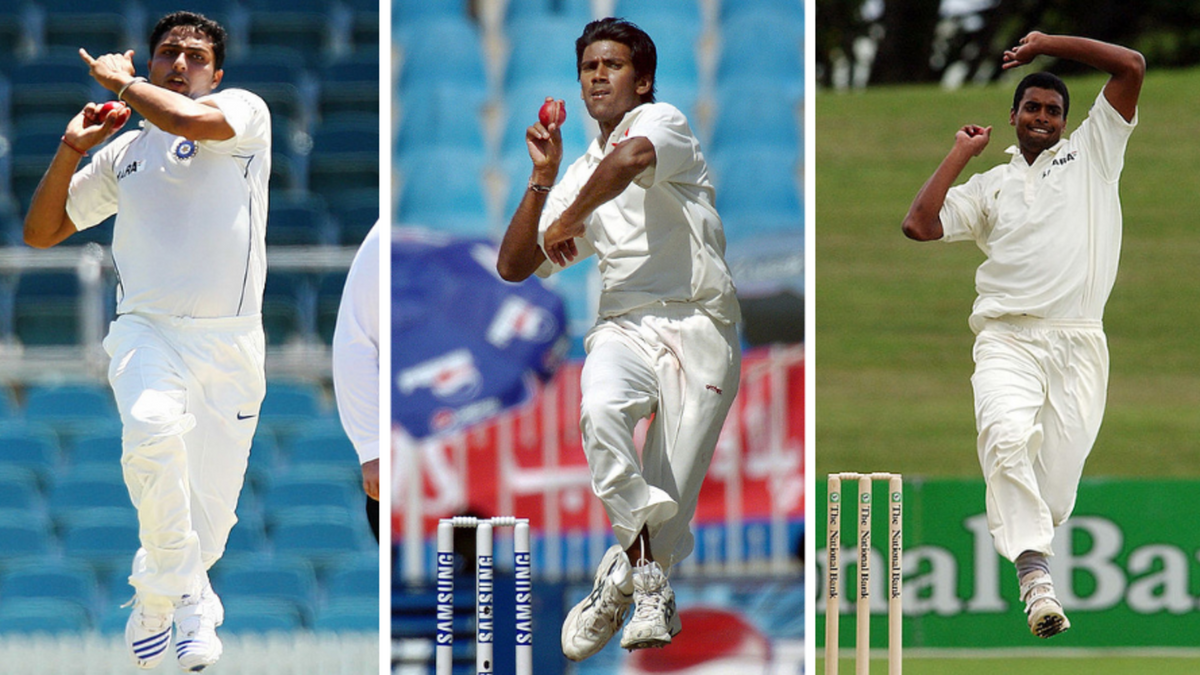
Some were journeymen of domestic cricket, others were fresh off the blocks, but the following Indian seamers, all tried at one point, had one thing in common – they couldn’t pin down a proper spot in the Indian Test team of the 2000s.
Long before India uncovered the formidable pace attack that they have today, fans were habituated to watching seamers play second-fiddle to the more assertive spinners through the Nineties. At the turn of the millennium, under Sourav Ganguly and John Wright, India started to try out a string of quick bowlers to form the next pace attack, hoping to challenge the best batsmen in the world.
While the decade gave India some of its finest bowlers in Zaheer Khan, Ishant Sharma and Irfan Pathan, the timeline also saw a list of discarded seamers who just couldn’t manage a lasting impression. We’ve mentioned bowlers who debuted in the 2000s and played all their games in the decade, with only one of them going on to play more than ten Tests in his career.
Tinu Yohannan
Tests: 3, Wickets: 5, Avg: 51.20, BBI: 2-56
Tall and imposing, Yohannan was one in a stream of Indian youngsters who popped up at the turn of the century. On debut in Mohali, Yohannan snared Mark Butcher off only his fourth ball, and sent back Marcus Trescothick later, capturing them both again in the second innings.
However, the next three spells went wicketless, and he managed just one wicket in the fourth one. Yohannan’s extra bounce and early swing was soon lost in the melee of other young seamers, and his Test career wrapped up within a year.
Iqbal Siddiqui
Tests: 1, Wickets: 1, Avg: 48.00, BBI: 1-32
Debuting in the same Test as Yohannan after sweating it out for years at the domestic level, the then 26-year-old Siddiqui picked up Graham Thorpe as his solitary Test wicket, bowling just eight overs with the new ball in the second innings. A handy lower-order batsman who drew comparisons with Kapil Dev due to his all-round skills, Siddiqui opened the batting in a short chase, and hit the winning runs to complete his debut. However, he wasn’t picked thereafter, playing first-class cricket for four more seasons before his retirement.
Sanjay Bangar
Tests: 12, Wickets: 7, Avg: 49.00, BBI: 2-23
Not an out-and-out seamer, Sanjay Bangar was a useful all-rounder who played many roles. The third debutant in the Mohali Test, Sanjay Bangar didn’t possess brisk pace like the others in contention, but was a workaholic no less, tirelessly sending down overs at the domestic level. On helpful pitches, he was nippy, generating appreciable early movement, and was even employed as a Test opener alongside Virender Sehwag.
He went largely unnoticed on debut barring a useful 36 down the order, and was generally employed as a third seamer, bowling more than ten overs only four times in 14 innings. After being tried out on tours to West Indies, New Zealand and England, Bangar was sidelined as India looked for more firepower in their pace attack.
Lakshmipathy Balaji
Tests: 8, Wickets: 27, Avg: 37.18, BBI: 5-76
Indians fans of the 2000s will have fond memories of Balaji, an unassuming, genial presence who briefly found a place in India’s Test team. A year after making his ODI debut, Balaji broke into a team searching for Javagal Srinath’s replacement, but didn’t seem to have much spice in his bowling. The perception changed next year, when he starred in India’s historic tour to Pakistan later that year, swinging the ball late and snaring early wickets.
Eight Tests in, Balaji was forced out due to a career-threatening back injury. While he did well to claw back into the white-ball side years later, let alone resume playing cricket, his Test place was lost as younger options emerged.
VRV Singh
Tests: 5, Wickets: 8, Avg: 53.37 , BBI: 3-48
A tall, well-built quick, Vikram Rajvir Singh was a breath of fresh air for an Indian generation used to watching lanky seamers hurl gentle medium pace. However, much like the rest, VRV’s career was harrowed by injuries right from the start. Impressing early in domestic cricket, he found a place in the Greg Chappell regime which focussed on developing a core of young Indian quicks.
He played all his five Tests overseas, in West Indies, South Africa and Bangladesh, but couldn’t make a lasting impact, often struggling with his lines even though he cranked up good pace. Not long after featuring in India’s first Test win against South Africa, in Johannesburg, he was left to slug it out in domestic cricket. He brought an end to his injury-riddled, ‘incomplete’ career in 2019.








